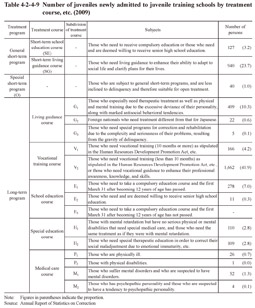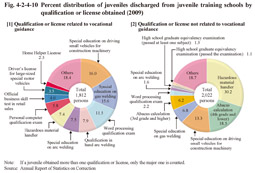2 Treatment provided at juvenile training schools
(1) Type of juvenile training schools and treatment programs
a. Type of juvenile training schools
The following four types of juvenile training schools are used to accommodate juveniles according to their age, level of criminal tendency, and physical and mental condition, etc.:
[1] Primary juvenile training schools: Juveniles generally aged 12 or older but typically younger than 16 and without serious physical/mental disability;
[2] Middle juvenile training schools: Juveniles generally aged 16 or older but younger than 20 and without serious physical/mental disability;
[3] Special juvenile training schools: Juveniles generally aged 16 or older but younger than 23 and without serious physical/mental disability but with strong criminal tendencies. However, juvenile inmates sentenced to imprisonment who are younger than 16 may also be accommodated; and
[4] Medical juvenile training schools: Juveniles generally aged 12 or older but younger than 26 and with serious physical/mental disabilities.
b. Treatment programs
Both short-term and long-term programs are available at juvenile training schools, with the former being further divided into general short-term programs and special short-term programs. Primary juvenile training schools and middle juvenile training schools implement both short-term and long-term programs whereas special juvenile training schools and medical juvenile training schools implement long-term programs only. Juveniles subject to the respective programs are as follows:
[1] General short-term programs: Juveniles who can be expected to be corrected and reintegrated back into society through continuous intensive short-term guidance and training as they are very likely to be promptly reformed (maximum term of confinement in principle six months);
[2] Special short-term programs: Juveniles who are subject to [1], but less inclined to delinquency, and who therefore suit more open treatment (maximum term of confinement four months);
[3] Long-term programs: Juveniles who are not suitable for short-term programs (maximum term of confinement in principle two years).
The type of juvenile training school gets designated by a family court following the decision to commit them to a juvenile training school. In addition, family courts can recommend short-term programs upon that decision if deemed appropriate, in which case the treatment programs are determined in accordance with the recommendation. In other cases juveniles receive long-term programs.
Table 4-2-4-8 shows the number of juveniles newly admitted to juvenile training schools in 2009 by type of juvenile training school and treatment program.
Table 4-2-4-8 Number of juveniles newly admitted to juvenile training schools by type of juvenile training school and treatment program (2009)
c. Treatment courses
Treatment courses have been established that include both general short-term programs and long-term programs (the treatment courses in long-term programs involve further divisions). Juveniles at juvenile training schools are provided with guidance in five areas, namely living guidance, vocational guidance, an academic education, health and physical education, and special activities. Each treatment course places a high level of importance on specific area involving correctional education (medical treatment is given higher priority in the medical care course) and provide matters that require attention in implementing correctional education in ensuring the most effective treatment to the juveniles categorized by their characteristics, including their criminal tendencies, academic abilities, future plans, and physical and mental condition.
Table 4-2-4-9 shows the type and subject of treatment courses, with the number of juveniles newly admitted to juvenile training schools by treatment course, etc. in 2009.
Table 4-2-4-9 Number of juveniles newly admitted to juvenile training schools by treatment course, etc. (2009)
(2) Correctional education
Correctional education is the core treatment provided at juvenile training schools and involves the five areas of living guidance, vocational guidance, an academic education, health and physical education, and special activities. Those unable to adapt to society due to physical or mental disabilities are provided with medical care. The treatment at juvenile training schools is divided into the three educational stages of orientation, intermediate, and pre-release. Correctional treatment is implemented based on individual treatment plans formulated for the individual juvenile by the directors of juvenile training schools that specify the goals, basic content, and methods to be used in each stage.
Treatment grades are established for juveniles at juvenile treatment schools in facilitating their reformation via raising their motivation to make voluntary efforts (treatment grades are divided into first to third grades, with the first and second grades being divided again into upper and lower grades). Newly admitted juveniles are first placed in the lower second grade before moving on to the other grades in accordance with the progress they have made in their reformation. Restrictions in their lives are alleviated accordingly.
Content of the abovementioned guidance in the five areas is as follows.
a. Living guidance
Living guidance is implemented on the following issues: [1] problems related to juveniles' ways of thinking, attitudes, and behavior that could lead them into delinquency, [2] problems related to juveniles' predisposition and emotions, etc., [3] problems related to the cultivation of aesthetic sensitivity, [4] problems related to juveniles' basic life style, law-abidance and self-discipline, and interpersonal relationships, etc., [5] problems related to their home environment (relationship with their families and friends, etc.), and [6] preparation for selecting a career, life planning, and social reintegration through various methods such as counseling, writing essays and a diary, and role lettering, etc.
In addition, “education from the victims' point of view” has been improved and enhanced in aiding juveniles to understand the delinquent acts they committed, the seriousness and thus the victims' feelings, etc., thereby enabling them be capable of responding to their victim more sincerely.
b. Vocational guidance
Juvenile training schools currently offer vocational guidance on courses that include welding, woodwork, civil engineering and construction, operation of construction machinery, agriculture and horticulture, office work, and caretaking services, etc. In 2009, 46.6% of discharged juveniles obtained qualifications or licenses related to the vocational guidance course, while 52.0% obtained other qualifications or licenses. Fig. 4-2-4-10 shows the percent distribution of discharged juveniles by qualification/license obtained in 2009.
Fig. 4-2-4-10 Percent distribution of juveniles discharged from juvenile training schools by qualification or license obtained (2009)
Since FY 2006 the Ministry of Justice in cooperation with the Ministry of Health, Labor and Welfare has been implementing comprehensive employment support measures, with part of those measures involving vocational counseling, etc. provided to juveniles at juvenile training schools by public employment security office staff members (See (6) of Subsection 2, Section 3, Chapter 4, Part 2).
c. Academic education
Juveniles at juvenile training schools who did not complete their compulsory education or those who need or wish to receive a senior high school education are provided with an academic education that is the equivalent of that which they would receive at school. An academic education is also provided to all the other juvenile inmates as supplementary education as required in helping them to acquire the basic scholastic abilities needed to lead a normal social life, or to proceed to a higher education, or to return to the school to which they previously belonged. Some institutions implement compulsory education or senior high school education through academic education programs entrusted to external schools, etc. Of juveniles discharged in 2009, 113 returned to junior high school and 116 to senior high school while a total of 313 juveniles received graduation certificates from their junior high schools while in a juvenile training school (Source: Annual Report of Statistics on Correction). The Certificate for Students Achieving the Proficiency Level of Upper Secondary School Graduates (high school graduate equivalency examination) has been made available at juvenile training schools since FY 2007. In FY 2009, 404 juveniles took the examination and 120 passed the examination, with 264 passing at least one subject (Source: The Lifelong Learning Policy Bureau, Ministry of Education, Culture, Sports, Science and Technology).
d. Health and physical education
Doctors and medical staff, etc. at juvenile training schools provide health education on disease prevention, etc. in enhancing juveniles' ability to maintain good health, with consideration also being given to their delinquency and actual living conditions before admission, etc.
Various sporting activities are implemented through physical education in enhancing their basic physical capabilities, concentration, patience, and endurance, with group games being utilized in order to develop the ability to comply with rules and cooperate in interpersonal relationships, etc.
e. Special activities
Special activities include [1] voluntary activities, [2] extramural educational activities, [3] club activities, [4] recreation, and [5] other events implemented at juvenile training schools.
As voluntary activities juveniles at most juvenile training schools can be assigned roles such as day manager, book manager, maintenance manager, or recreation manager, etc. in developing greater autonomy and cooperation. In addition, meetings and homerooms are held and in-house magazines, etc. published. Social service activities and field trips, etc. are also implemented as extramural educational activities. As social service activities many institutions implement volunteer activities at welfare facilities and cleaning/beautification activities at nearby parks and public facilities, etc.
(3) Measures for guardians, etc.
Guardians play a significant role in the reformation/rehabilitation of juveniles, and hence juvenile training schools are now providing guidance and advice that can help guardians cope with any problems concerning the delinquency of a juvenile, offering information on correctional education, and holding guardian meetings.
(4) Cooperation and assistance from the private sector in treatment
A wide variety of private volunteers, including volunteer visitors, chaplains, members of the Women's Association for Rehabilitation Aid and members of BBS associations, etc., are involved in support activities at juvenile training schools.
Volunteer visitors provide juveniles with advice and guidance on mental problems they have along with cultural guidance, etc. As of the end of 2009, 637 persons had been commissioned as volunteer visitors to juvenile training schools (Source: The Correction Bureau, Ministry of Justice).
Chaplains can provide religious education upon request. As of the end of 2009 juvenile training schools included a total of 372 chaplains (Source: The Correction Bureau, Ministry of Justice).
Members of the Women's Association for Rehabilitation Aid and members of the BBS associations, etc. support educational activities at juvenile training schools in a variety of ways. For example by regularly visiting juvenile training schools to participate in school events such as birthday parties, cherry blossom viewing parties, and Coming of Age ceremonies, or to play games and sport with juveniles or participate in debates as judges. Interactions with these volunteers can serve as significant encouragement to juveniles to rehabilitate themselves.


